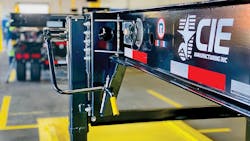Much as in the US, trailer demand in Europe has slipped substantially since the markets were red hot in 2018, and the 2019 downturn is expected to linger into 2020, according to forecasts by transportation consulting group CLEAR International.
A lackluster economy in Western Europe during the first half of 2019 still saw trailer demand up slightly, but the market took a decided turn for the worse in the second half, resulting in a 14.9% decline for the period. For the year, trailer demand in Western Europe was off 6.6%, CLEAR reported.
Results, as usual, varied significantly from country to country. Several large West European countries did see some growth in the first half of 2019, specifically Belgium, France, Germany and the UK, according to CLEAR. Spain, Italy, Austria and Denmark all had falls in trailer demand from Q1. However, all countries except Norway saw a drop in trailer registrations in 2019, with a wide variation in the size of the year-over-year result ranging from +2% to -29%.
CLEAR has forecast a cyclical slowdown (but not a recession) in European economies for some years. The catch-up demand that has been pushing the trailer market is now over, CLEAR stated.
“The trailer parc [body of registrations] is fully replenished despite the fact that road transport demand has yet to return to 2006 (pre-global financial crisis) levels,” said Gary Beecroft, managing director of CLEAR International. “Furthermore, it is 10 years since the decimation of the trailer market in 2009 and the market has never gone 10 years without a slowdown.”
As in the US, Western European trailer demand reached a very high level in 2018, rivaled only by 2007, which had an “unnaturally” high level of trailer sales largely brought on by the number of countries that joined the EU in 2004-07. And, again as in the US, these factors point to a fall in demand for new trailers heading into 2020.
“Fortunately for the industry, the fall will be relatively modest and short-lived,” Beecroft added, and the downturn should be kept in perspective.
Indeed, from 2017-21 trailer registrations are forecast to be higher than any five-year period in history, even though that will include the 2019-2020 slip. The previous record-breaking five-year period was from 2004-08.
And the fall in trailer demand in 2019 was smaller than forecast at the beginning of the year. However, this means that a further fall is forecast for 2020 with recovery delayed until 2021, the CLEAR report notes.
“Therefore the industry is achieving both high levels of output and relative stability in what is traditionally a volatile sector of the vehicle market,” Beecroft said. “The trailer parc [fleet size] will set a new record level every year to 2023—another reason why increased demand for new trailers is unlikely until 2021.”
The annual results from Schmitz Cargobull AG, the EU’s largest trailer manufacturer, confirms the CLEAR analysis.
“A glance at the figures shows that the last business year of 2018/19 was a solid year for Schmitz Cargobull,” said Andreas Schmitz, chief executive officer. “Due to the overall economic and political development, no further growth is expected in the current 2019/20 business year. However, we believe that the Central and Eastern Europe regions and Spain will remain relatively stable, while a reduction is expected in other countries.
“We are keeping all flexibility options open and assume that we will be able to implement the necessary savings without any cuts within our core team.”
Eastern Europe
As background, CLEAR’s report on the East European trailer market notes that countries in region joined the EU in 2004-07, which resulted in “booming demand” for trailers. Semi-trailer demand soared as the volumes of international transport increased, both within Eastern Europe and between East and West. From 2002 to 2007 the compound annual growth rate for trailer demand was 25.7%. Demand broke the 100,000-unit barrier in 2007 but fell to 40,000 in 2009 as a result of the global financial crisis.
Demand for trailers in Eastern Europe has grown every year for the last six years, but that growth has been quite moderate, according to the CLEAR analysis. Nevertheless, trailer sales in 2018 were the third highest on record, only surpassed in 2007 and 2008. The forecast for 2023 is that registrations of new trailers will be heading toward an all-time record.
However, the short-term outlook is “anything but positive,” CLEAR suggests.
Demand for both trailers and trucks has continued to plunge in 2019. The East European demand forecast for trailers in the five-year period from 2019 to 2023 has been reduced by 13,500 trailers, with Turkey accounting for 70% of that reduction. Consequently, trailer demand in the region was down 11% in 2019 but there will be a return to growth in 2020/21.
While growth for the Eastern Europe region has been positive since 2012, country-by-country results have shown “wild variations,” both positive and negative, CLEAR reports.
Turkey was the second largest market in Europe from 2010 to 2014—only Germany had higher trailer demand. However, since 2014 demand has fallen every year as the country was beset by both economic and political problems, complicated by war and instability in neighboring Syria. As a result, demand for new trailers has fallen by more than 50%.
“Turkey is one of the Big 3 trailer markets in Eastern Europe. The lack of political stability and conflict on Turkey’s borders has destroyed business confidence,” Beecroft said. “CLEAR expects some recovery in Turkish commercial vehicle demand next year but with the Turkish army currently in Syria this is far from certain.”
Russia, the largest trailer market in Eastern Europe until 2010, suffered a 50% fall in demand between 2011 and 2015, but had an “astonishing” recovery in 2017/18 and is now the second largest market to Poland. Russia will become the largest trailer market in the region during the forecast period, according to CLEAR.
Poland, by contrast, has been “a model of stability.” While more populous countries in the region have suffered significant instability, Poland quietly became the largest market for trailers from 2016 to 2019, CLEAR notes.
Global outlook
More broadly, the growing use of road infrastructure in meeting freight transportation needs of various industries in several countries around the world, coupled with the rising need for cargo transport in numerous emerging economies, sets the tone for “impressive” growth of the semi-trailers market, according to a recent study by Transparency Market Research.
Indeed, growing demand for long-distance trucks in heavy industries will be the key to propelling the sales of semi-trailers. The semi-trailer market is projected to clock a compound annual growth rate of 3% during 2018–2026, with a worth of $24 billion by the end of the period, TMR reports.
“Application of road freight in transportation of cargo has been growing on the back of strides in e-commerce and international trade,” say the analysts with TMR. “Sizable opportunities in the semi-trailers market stem from the demand for semi-trailers as cost-effective means of transport for managing municipal and industrial waste in urban centers.”
The more-than-4 axle segment is expected to gather more traction among users in the semi-trailers market.
Among all industries, heavy industry has emerged as the one with substantial use of semi-trailers, particularly in steel, mining, chemical, and manufacturing.
Stake trailers and curtain-sided trailers have emerged as a prominent segment, and will continue to see large demand; the report attributes this to their cost-effectiveness and operational flexibility.
The study also takes a close look at the macro-economic trends that underlie the expansion of the semi-trailers’ demands around the world. Rapid growth of road freight for heavy goods transport in numerous industrialized economies around the world has been key to the expansion of the semi-trailers market.
The TMR report notes that strides in manufacturing has driven road freight transport: The sector’s overall contribution has undoubtedly increased over the past 25 years.
And crossborder ecommerce is expected to rise at a significant margin from through 2026, which will also augment the demand for semi-trailers in logistics.
Though market analysts paint a bright prospect for semi-trailers, a few constraints should concern stakeholders, the TMR study suggests.
In many countries, road infrastructure is still at the developmental stage, evident in the absence of wide roads connecting urban and rural areas.
Maintenance activities in some parts of the world have been slow to keep pace with the rise in road freight transport.
Trucks with integrated trailers have become a viable alternative for semi-trailers, thereby hampering the growth in the semi-trailers market.

